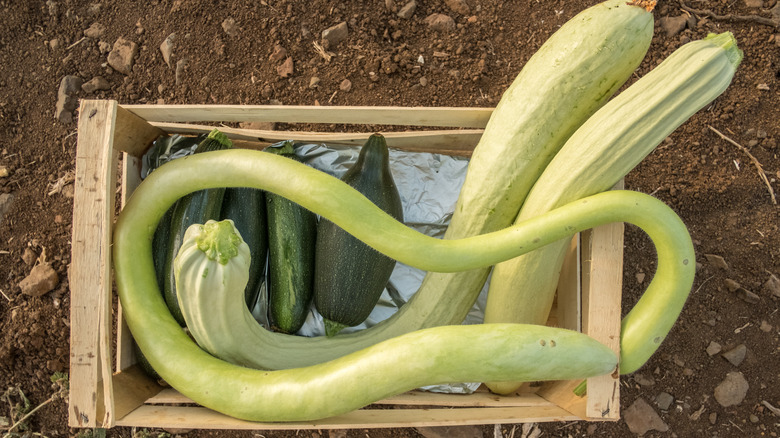The Wacky Looking Italian Summer Squash You Need To Look Out For
When you hear the word "cucuzza," your first response might be, "scusa?" And we don't blame you. In the world of vegetables, cucuzza is definitely one that sneaks (or should we say, snakes) away unnoticed each summer — but we're here to tell you why it should be on your radar.
This Italian summer squash goes by many names, including, but not limited to, Italian edible gourd, longissima, and suzza melon. Perhaps the most fitting of its names is the serpent of Sicily, and perhaps the most fun is googootz — which is essentially slang for the word cucuzza (think the "gabagool" to capicola). It technically means "big squash" or "zucchini," but is also used as a strange term of endearment that means "useless person."
Whatever you want to call it, cucuzza doesn't regularly make our grocery lists here in the U.S. It's not exactly easy to find, but it's not impossible either. Whether you get your hands on it or not, googootz is worth knowing about.
Everything you need to know about cucuzza
Think of cucuzza as the long-lost twin of zucchini. While it's technically a gourd rather than a squash, it's very similar in terms of its light texture and its slightly sweet, slightly bitter flavor. It's long, curvy, thin, and a lovely pastel green in color that only becomes more prominent when you cook it, making it a fun, colorful addition to any meal.
The gourd does look surprisingly serpent-like, sprouting up like a little garden snake in the hot and humid summer climate of Africa and southern Italy. They're in season from July to December, and can twist and turn for up to 3 to 4 feet; some are even able to pop a growth spurt of 10 inches in one day.
So, where can you find one? You might get lucky and spot cucuzza at your local farmer's market or at a nearby Italian market (you've most likely got the best shot if you're on the East Coast or up near New Jersey and New York, where Italian-Americans are aplenty). But if all else fails, you can buy the seeds online and plant some googootz yourself.
How to cook and eat cucuzza
If you're lucky enough to grab some cucuzza, be sure to pick one that's firm to the touch rather than soft or bruised, and ideally with the stem still intact. Unlike zucchini, this gourd has a tougher skin that you'll need to cut or peel off, but it's up to you whether you prefer to leave the seeds in or scoop them out.
However, since cucuzza is so similar to zucchini in terms of texture and flavor, you can prepare it in many of the same ways. That means it'll be great boiled and sautéed, grilled, or baked. In southern Italian dishes, cucuzza is often sautéed with things like garlic, tomatoes, and onions and eaten with pasta.
But you have endless options with cucuzza. You can stuff it with other veggies, meat, or cheese. You can throw it in a casserole or a stir fry. You can use it to make fritters or as the base of a soup. Its mild, slightly nutty flavor will go great with aromatic spices like chili powder and curry, or fresh herbs like oregano and basil.


